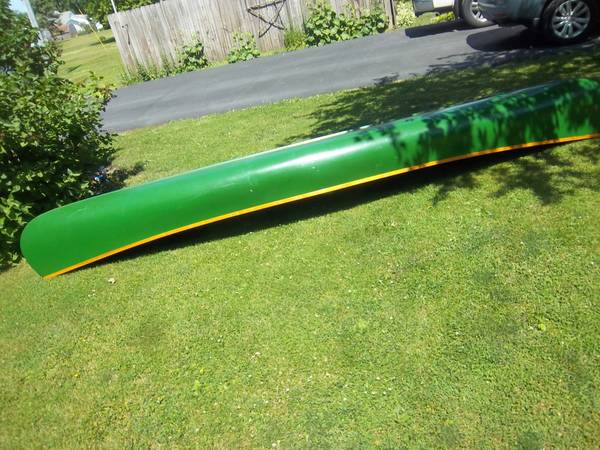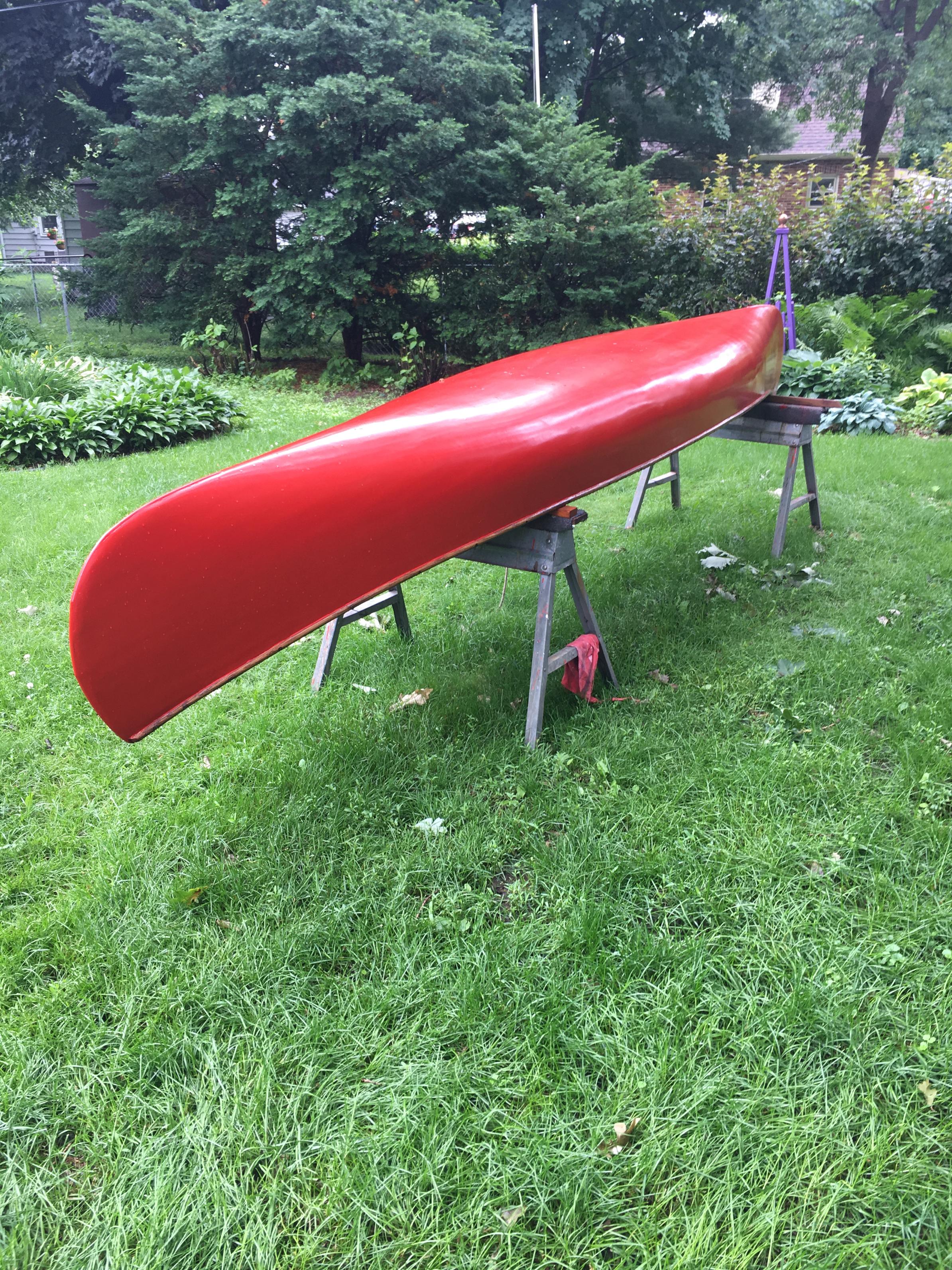|
06/30/2019 12:59PM |
|
06/30/2019 03:42PM |


|
06/19/2019 10:52AM |

|
07/01/2019 02:18PM |
jwartman59: "Just finished restoring this 1941 peterborough. Originally it had a boot keel. I decided not to use it as it’s function was to protect the canvas from rock damage, the keel added nothing to the canoes performance, in fact it made the canoe slower. Many canoe restorers do not use the keel
"
Fantastic looking canoe jwartman59.
|
06/19/2019 11:38AM |
|
06/19/2019 11:50AM |
WonderMonkey: "Dry bags full of water and hooked to the bow carry handle will add some weight to bring the front end deeper. Dump at the start of a portage, fill at the end."
Yes - I carry a large(13"x36") Coghlans DrySack for this exact purpose when paddling with my son. It's the perfect ballast as it will not impact the canoes buoyancy, is easy to fill/empty and is infinitely adjustable.
The ease/convenience of a filling/emptying a drysack means I would never consider using rocks. I personally would not want to use rocks for a multitude of reasons. I do use a melon size rock in a net for an anchor... but no rock ballasts in my canoe.
|
06/19/2019 12:24PM |
|
06/20/2019 03:58PM |
cyclones30: "I'm not doubting the buoyancy part, but I'd assume if you flip the canoe the loose rocks will be on the bottom of the lake. ... "
The error in your assumption is that the canoe flips. What seems as likely, is that the canoe tips enough to fill with water but not enough to dump the rocks.
Your canoe filled with water is still lighter than the water displaced so remains at the surface. Your canoe filled with water and rocks is heavier than the water displaced and will settle on the bottom.
I hope this sinks in (little pun there)
|
06/17/2019 04:26PM |
|
06/19/2019 09:56AM |
Here is a link to one of his articles.
https://paddling.com/learn/rules-for-canoeing-big-water/
Cliff Jacobson safe paddling
I hope the link works! ?????
|
06/19/2019 05:49PM |
sns: "frankpeach: "I will absolutely try the rocks idea next time! "
I feel like there is a safety issue with the rocks solution. Water in drybags have neutral bouyancy. Suspect rocks might be a concern if you dump."
I'm not doubting the buoyancy part, but I'd assume if you flip the canoe the loose rocks will be on the bottom of the lake. We didn't have any extra dry bags with us and there were plennnnnty of rocks to be had on shore so they made due with what we had and it may have saved the trip in more ways than one.
|
06/18/2019 10:28AM |
Weathervaning is hard to combat, especially when you have lighter & less experienced paddlers up front.
|
06/19/2019 04:53PM |
awbrown: "When my grandson's were young, we always paddled with them (1 at a time) sitting backwards in the stern seat and me backwards in the bow seat. Of course, the kids would play more than paddle.
"
Many of the popular kevlar hulls are asymmetrical which makes turning them around ill-advised. Dry bags filled with water is a good way to address weight imbalance. Start first by cramming as many packs and the heaviest packs forward of the yoke. The less weight you have to add the better.
|
07/01/2019 11:18AM |

|
06/17/2019 05:59PM |
|
06/17/2019 07:09PM |
More weight might help a fair amount.
I sometimes fill dry bags with water and clip them to the thwarts, and play with their volume (weight) & location to help trim and performance.
|
06/17/2019 09:39PM |
sns: "I am not an expert, but I doubt a keel will do much.
More weight might help a fair amount.
I sometimes fill dry bags with water and clip them to the thwarts, and play with their volume (weight) & location to help trim and performance."
+1
|
06/17/2019 10:14PM |
Of course, as others have noted, loading is critical in every boat: weight to windward.
|
06/17/2019 10:35PM |
|
06/18/2019 12:32PM |
|
06/19/2019 08:42AM |
frankpeach: "I will absolutely try the rocks idea next time! "
I feel like there is a safety issue with the rocks solution. Water in drybags have neutral bouyancy. Suspect rocks might be a concern if you dump.
|
06/19/2019 08:00AM |
1) keep pointed directly into the wind. A 10 deg difference to either angle and the next thing you know your pointed in the wrong direction and there is nothing you can do about it
2) Paddle backwards until you can find a shore to redirect.
I will absolutely try the rocks idea next time!
|
06/19/2019 08:12AM |
WonderMonkey: "Dry bags full of water and hooked to the bow carry handle will add some weight to bring the front end deeper. Dump at the start of a portage, fill at the end."
I like this method also, much easier on the bottom of my Kevlar canoe. I only use this when traveling solo in my 16' tandem UL Wenonah Adirondak, turning the canoe around and paddling from the bow seat.
This would also be a good solution to paddling with a child in the bow seat, will allow for weight up front where you need it without taking up much space.
|
06/21/2019 01:23PM |
|
06/18/2019 07:18AM |
|
06/17/2019 03:48PM |
I have had a Kevlar Canoe for roughly 18 years, and have not paddled for a while. IN the past I had no issue without a keel as my wife was an accomplished paddler.
Well on the most recent trip, I took my 7 year old daughter, and noticed there was no possible way to win in a windy condition. I realized going in, that I would be doing 90% of the work, but with her weight, lack of paddling, and lack of keel it was near impossible to go anywhere with even the slightest side wind. It took all my effort, and even that sometimes failed. I loaded all the gear up front, under, in front and behind her but still the front would get thrown.
The aluminum canoe with us, had a similar set up as far as paddling team, but had a keel and they were able to track better, not perfect but better.
As we paddled out with the wind, we noticed the same thing coming in, often sadly with novice paddlers that had little or no experience. Trying to paddle into the wind with Kevlar and a kid up front, and many resigned to paddling backwards. They all looked miserable. I have to imagine with the number of Kevlar Canoes at outfitters this is a regular challenge with novice paddlers, and families.
So in a round about way, I am curious if anyone has tried to put a keel, even make shift on a Keel-less canoe to help, or has other strategies.
|
06/17/2019 08:23PM |
|
06/30/2019 10:16AM |
On our day trip I piled rocks in the bow. Appropriate trip planning for youth is an important part to ensure our enjoyment. LIS River and a couple small lakes and easy portage's. We had great time.
I have padddled with and without keels and don't believe a keel is a factor in controllabilty. The keel is a structural entity.
I hope you have many great trips ahead of you. We are looking forward to our next one.
|
06/20/2019 09:37PM |
OCDave: "cyclones30: "I'm not doubting the buoyancy part, but I'd assume if you flip the canoe the loose rocks will be on the bottom of the lake. ... "
The error in your assumption is that the canoe flips. What seems as likely, is that the canoe tips enough to fill with water but not enough to dump the rocks.
Your canoe filled with water is still lighter than the water displaced so remains at the surface. Your canoe filled with water and rocks is heavier than the water displaced and will settle on the bottom.
I hope this sinks in (little pun there) "
Yes, true. We told them if it goes over pull it all the way over. They were far safer with the rocks then without in that head/cross wind so I felt better about it.